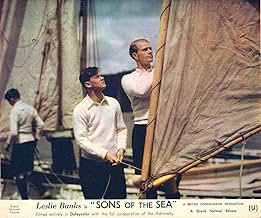The real star of this film (as it was in 1939), isn't an actor, but the then new Dufaycolor - full colour process. It is also possibly the first feature film to be shot using a single color negative (in contrast to the three b/w negatives needed for the three-strip Technicolor camera). In the case of Dufaycolor, the negative film was ruled with a mosaic of very fine red/green/blue lines. This is important to know when this film is viewed today as the colour is completely different from Technicolor. Because the film was shot with a conventional b/w camera, the restrictions of the bulky three-strip camera freed. This makes for some smooth, nimble camerawork. As a bonus, there are a good deal of clear, bright outdoor shots, the result of much filming around the cool blue seas and hamlets that stretch and cover the South coast of England. A landscape about to be changed by the approaching War. Even this film is intended to be a 'flagwaver' and a nod to Admiral Nelson is given in the final sequence. This is because, in this case, the Navy is honoured, including the Naval training college. The storyline is sadly, a conventional spy story. This is given depth by the always excellent Leslie Banks and the welcome appearance of Cecil Parker. The colour consultant on the film was the British colour film expert Adrian Clyne. He had good concepts for the way progressive colour films should look (which sharply differed with that of Technicolor's Natalie Kalmus). Even after 60 years, Clyne's composition is modern and vibrant. If Kalmus wanted pastels in 30s Technicolor, Clyne wanted effective colour compositions and wasn't afraid to use colour dramatically, but without the need to detract from the drama. In all, the film is an interesting experiment. No other Dufaycolor films were made. War shortages sealed the fate of this process. Viewed today, the drama is only average and anyone expecting a good spy story may be disappointed, however if looked at from the point of view as one of the few 1930s British films in colour (which has survived well) it is stunning.


























